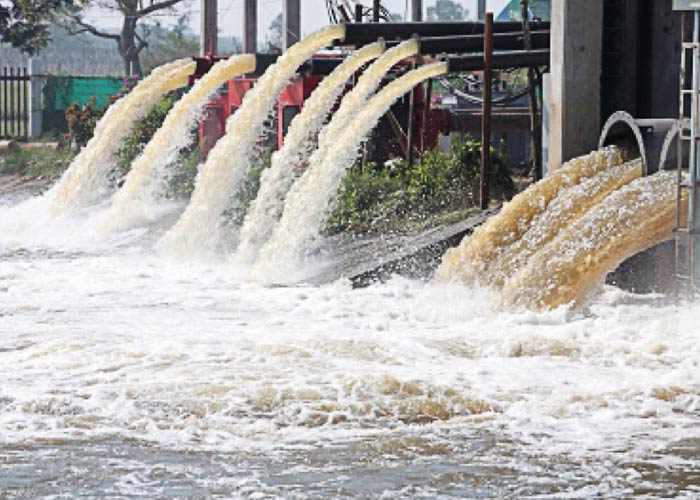Forests have been an integral part of the life of man since time immemorial. They are truly life-giving. They help in bringing rain and increase the fertile strength of the earth. They check the danger of floods by absorbing rain water. This absorbed water gradually goes back to the whole environment. Forests prevent the erosion of the land, rule out droughts and check the spread of the desert.
But as the civilization developed, the man started cutting trees to meet his needs. The forest continued to be harvested and it had an impact on the environment. Today, in the blind race for development in the world, forests are being cut down rapidly, due to which the balance of environment is deteriorating and the danger for the survival of life on Earth is increasing.
What is Deforestation?
Forest is a broad area that is fully covered with trees that improves the entire biological potential of the environment. Trees have a greater role in maintaining the environmental equilibrium than any other component of nature. They play the role of a mute but living guardian in the enrichment of the useful elements for nourishment of life. Trees and plants protect us against global warming by absorbing extra and harmful carbon dioxide from the atmosphere. In a year, trees spread over one acre absorb as much carbon as a car produces covering a distance of 26000 miles, on an average.
Deforestation occurs when forests are converted to non-forest areas without making adequate forestry for urbanization, agriculture and other reasons. It implies permanent destruction of forests and woodlands for domestic, industrial and mechanical needs. At one time the vast majority of the earth was covered with forests, but today its size is diminishing day by day.
Deforestation Information and Facts
Forests are known as Earth’s lungs. They absorb carbon dioxide (CO2), which is a greenhouse gas. Deforestation slows down this rate of absorption, speeding up the rate of global warming in return. As massive deforestation goes on, the forest area of the world is declining, which is very worrisome from the environment point of view. Rampant cutting of trees has given rise to unbalanced weather cycle, which has also affected human life.
The latest report from the Global Forest Resource Assessment (GFRA) states that between 1990 and 2015, the total forest area has decreased by three percent and the area of more than 102,000 lakh acres has shrunk to 98, 810 lakh acres. That is, there has been a decrease of 3,190 lakh acres of forest area. Notably, this area is equivalent to the size of South Africa. It has been said in the report that natural forest area has decreased by six percent. The situation of tropical forest areas is also pathetic. They are losing forest area at the rate of ten percent.
The problem of deforestation in terms of tree-cutting is the highest in third world countries. Struggling with the development process, these countries have not restrained their population growth. Forests are being cut fast in their longing to be among the developed, industrialized countries in the world.
Due to rapid deforestation happening on the Himalayas, land erosion is increasing rapidly. According to a research, the rate of erosion in the Himalayan region has reached up to seven mm per year. In 1947, 45 percent of the area was covered with forest cover, but after that every year there is a continuous decrease due to tree cutting, resulting in decrease of rainfall.
Causes/Reasons of Deforestation
- Since the beginning of agriculture, there has been a reduction of 40% in the forests worldwide. The three-fourths of the loss occurred in the past two centuries, because the land was cleaned to meet the demands of agriculture and wood.
- Besides, the cutting of trees has been going on for years for the purpose of development work, residential needs, industries and mineral exploitation.
- Trees are cut for domestic fuel, wood, coal business, furniture and other physical resources.
- Despite various laws and regulations, deforestation continues due to unscientific and lopsided development, population explosion and growing materialistic culture.
- Sadly, the prevailing model of development is dependent on indiscriminate exploitation of resources.
- According to environmental experts, the activities of human beings have accelerated the deterioration of nature and it has seen unusual rise in the last 50 years.
- To meet the immediate needs of physical prosperity of man, indiscriminate cutting of trees began and its far-reaching consequences were ignored.
Impacts/Effects of Deforestation
- Deforestation has caused great damage to the environment. The entire ecological cycle has become disturbed, which is visible everywhere in the form of various types of destruction.
- Untimely changes in weather, excessive rainfall, drought, etc are the ill effects of destruction of trees, which are integral to maintenance of natural balance.
- There are new additions in the series of nature disasters: landslides and soil erosion.
- A large part of the fertile land is being lost every year.
- Along with that, innumerable people are losing their lives every year.
- Cutting of forests is increasing carbon dioxide in the environment. Destruction of forests is proving to be poisonous to the environment with two billion tonnes of extra carbon dioxide dissolved in the atmosphere every year.
- Increasing carbon dioxide in the atmosphere, deforestation and global burning of fossil fuels can cause large-scale climate change. If the level of carbon above the natural protection level goes on increasing per year due to human activities, then it will almost be doubled in 40 years.
- Deforestation and degradation in their area have contributed about 20 percent of global greenhouse gas emissions (GHG), although forests absorb them, if properly managed.
- Global warming has increased due to ruthless deforestation, and the balance of nature is deteriorating.
- Many creatures are facing extinction.
- As per an estimate, seven million hectares of forest area is being destroyed worldwide in the name of development every year. It is harming the ozone layer considered to be the protector of life.
- According to ‘Nature Geoscience’, the loss of the ozone layer has increased the number of certain types of very short-lived substances (VSLS) which is extremely dangerous to the existence of wildlife and human beings.
- Scientists say that these special types of VSLS are ninety percent responsible for damaging ozone.
- Due to environmental pollution as a fall-out of deforestation, there has been an increase in human diseases.
- As a result of the increase in global temperature, there is a decline of 20 to 25 percent in crop production. The Earth’s fertility is decreasing.
- One of the major utilities of forests is that they absorb water in large quantities during flooding quickly. But due to deforestation on a large scale there are no trees to absorb water as a result of which there is a loss of many lives in this way.
- The roots of the trees bind it to the soil and make it underlying bedrock. That’s how the trees are getting off the soil from getting clogged or by natural agents like water. When the trees are uprooted, there will be nothing to hold the soil together to increase the risk of landslides which can seriously threaten people’s safety and damage their properties.
Impact of Deforestation on Bio-diversity
According to World Bank estimates, forests provide habitation for about two-thirds of all the species of the Earth, and harvesting of tropical rain forests can damage the biodiversity of about 100 species in one day.
As per a recent report of the World Wildlife Fund and London’s Zoological Society, two-thirds of wildlife will end up on Earth by 2020. This report says that due to indiscriminate harvesting of forests worldwide, increasing pollution and climate change, the last four decades have seen a huge decline in the number of wildlife. The number of wildlife has decreased by 58 percent from 1970 to 2012. Along with endangered organisms such as elephants and gorillas, vultures and reptiles are rapidly disappearing. The report estimates that by 2020, wildlife can fall by as much as 67 percent.
According to scientists, due to unbridled harvesting of trees and climate change, many species can gradually be displaced towards the Polar Regions or higher mountains. If that happens, it is bound to have a negative impact on diversity and ecological balance.
This apprehension is not unfounded because climate change was the reason for the extinction of a monsters called dinosaurs who ruled the Earth for nearly twelve crore years. If climate change is not taken seriously by taking steps to stop deforestation, then it is bound to eradicate the existence of organisms from the earth in the coming years.
Deforestation in India
Since India has adopted the development model of eight and nine percent, human intervention has increased in nature. As soon as Uttarakhand was formed, the process of digging, binding and spoiling the rivers began.
According to the Forest Status Report-2011 released by the Ministry of Environment and Forests, the forest and tree areas are spread over 78.29 million hectares in the country, which is 23.81 percent of the country’s geographical area, whereas f forests should be 33 percent of any country’s area. Compared to the 2009 assessments, after considering the explanatory changes, the forest area of the country has decreased by 367 sq km. 15 states have recorded an increase of the gross 500 sq. km in forest area, in which Punjab is at the top with 100 sq km forest area increase. 12 states, union territories (especially North-Eastern states) recorded a deficit of 867 square km. The deficit in the forest area of the Northeast is mainly due to changes in agriculture.
In almost every state of the country, deforestation in the name of development and other activities is continuing. Large power projects are being built for electricity in Uttarakhand. For these power projects big dams are being constructed on the rivers, tunnels are being built by digging the mountains.
Forests are being cut, which has made the hills completely naked. Due to deforestation, soil erosion is occurring rapidly. Because of this, rivers and mountains are taking revenge in the form of landslides and floods.
Many rivers, which are the country’s lifelines, dry up in the summer, while during the monsoon, they are flooded. The main reason of the devastation in recent years in Himachal and Kashmir is the unbridled cutting of jungles.
The State Governments, along with the Central Government, need to seriously ponder on this issue, because when there are no trees in the country, the country will suffer from pollution. Then how will it develop?
Due to cutting of trees, the number of forest animals and other animals that balance the environment is decreasing. This has increased the threat of climate change. We need to understand the importance of forests and also make the common people aware; otherwise there will be no other choice except to repent.
Solutions to Prevent Deforestation
- The main cause of the growing crisis is the rise in atmospheric temperature, increasing levels of pollution, extensive erosion of forests and land, etc. Therefore, we should take steps for the prevention of haphazard deforestation.
- Apart from this, the forest area should not be reduced for agricultural expansion.
- The ‘transfer of cultivation’ should be controlled and if possible, it should be eliminated.
- Deforestation for the development of the cities should be stopped.
- Procedures such as preventing the burning of fossil fuels and converting some land for crops into forests can bring about improvement in the circumstances, but for this we will have to initiate a sort of social revolution.
- Continuous efforts are being made about environmental protection for decades.
- In the wake of global problems such as climate change, natural disasters, floods, storms, landslides etc, from time to time, the United Nations has continuously tried to focus on climate by providing protection to forests through its various agencies.
- Massive efforts have been taking place to prevent the environmental imbalance, but there has been little change in the situation.
- Now there is a need to create and implement such laws, which can prevent forest area imbalance due to deforestation.
- On the other hand, the level of public awareness should be so high that people treat tree-plantation as the goal of their life.
- Forest planning should be implemented just like family planning. Under this, the ban on cutting should be tightened and complete implementation should be started on developing new forest areas.
- People should imbibe the kind of attachment that the Bishnoi society of Rajasthan has towards animals, birds and forests.
- The public should take inspiration from the previously run movements and campaigns to save the environment.
- Indigenous communities of forest dwellers have inborn attachment to the forest, land and water. They should be made as protector of the forest wealth.
- In 1973, Chandi Prasad Bhatt in Uttarakhand organized Chipko Movement to protect the forests from traders; the movement derived its name from the act of hugging the trees by villagers to prevent the contractors’ from felling them.
- The women of the hills, under the leadership of Bhatt, used to go into the forest and form a circle around the trees preventing the men from cutting them down.
- Taking a cue from the past, panchayats should be put in charge of forest protection.
- Plantation should be done in the premises of every educational institution, and every government office.
- A meaningful campaign of ‘one family, one tree’ should be run.
- If the trees are properly planted in cities today, the problem of pollution and excessive heat due to nuclear power plants can be solved.
- Every city should become a green city. As long as there is forest, there is life.
Role of WWF to prevent Deforestation
Worldwide Fund for Nature (WWF) is one of the world’s biggest conservation organizations engaged in conservation of wildlife and nature. Formerly it was named World Wildlife Fund.
The institution has a big role in preventing deforestation as its aim is to preserve genetic organisms and ecological differences. It seeks to ensure that renewable natural resources are used in conformity with the present and future interests of all the living beings of the earth. By encouraging tree plantation, its goal is o prevent the growing degradation of the natural environment of our planet.
According to a recent WWF report, 13 lakh people are employed directly by forest based industries, while 41 lakh people are informally working in these industries worldwide. Large scale forests are being eliminated for industrialization and urbanization, which is a matter of grave concern. Statistics show that after 1990, the number of rain forests in the world has decreased by half. According to the Worldwide Fund, more than half of the world’s jungle has disappeared in the last 50 years.
WWF is playing a big role in conserving and promoting forests, helping in the formation of a future in which human beings reconcile with nature.
Conclusion
Biodiversity is a natural resource which cannot be made again if it is finished. That is, its extinction happens forever. If not taken seriously, then it is certain to eradicate the existence of living beings from the earth in the coming years. To save the biodiversity, it is necessary to save forests.
Deforestation is at the root of most of the environmental problems. The problems of global warming, floods, droughts, etc have arisen due to deforestation. Life on Earth can last only if we protect forests. The unbridled cutting of trees is putting the existence of various animals and birds on the planet in jeopardy. If the deforestation goes on unabated, then the day is not far when the life of all species will run into crisis.







